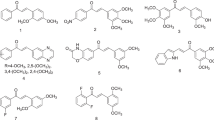This work was aimed at the synthesis and investigation of the cytotoxic activity of a series of Schiff bases having (4-substituted-benzylidene)-(3-phenyl-1,2,4-oxadiazol-5-yl)methylamine structure with different electronic natures of substituents in the phenyl ring. Thus, the study was intended to observe the effect of substituents with different electronic properties on the cytotoxic activity. The synthesized series of compounds (OP) were obtained by six-step synthesis with yields ranging from 12.23 to 25.77%. The chemical structures of these compounds were elucidated by H NMR. The cytotoxicity of compounds against human oral squamous cell carcinoma cell lines [Ca9-22 (gum), HSC-2 (mouth), HSC-3 (fluent), HSC-4 (language)] and human oral normal cells [HGF (gum fibroblasts), HPC (pulp cells), and HPLF (periodontal ligament fibroblasts)] was tested by MTT assay. Among the group of six OP compounds, bromo derivative OP2, non-substituted derivative OP1, and chloro derivative OP3 showed higher cytotoxicity (2.71-, 1.56-, and 1.53-fold, respectively) than the reference compound 5-FU. In addition, OP2 (3.27) exhibited the greatest selectivity index in this group. These compounds can be considered to be model structures for further studies.

Similar content being viewed by others
References
S. J. Shaw, Mini Rev. Med. Chem., 8 (3), 276 – 284 (2008).
H. Varmus, Science, 312 (5777), 1162 – 1165 (2006).
M. R. Harrison, K. D. Holen, and G. Liu, Clin. Adv. Hematol. Oncol., 7 (1), 54 – 64 (2009).
G. D. Diana, D. L. Volkots, T. J. Nitz, et al., J. Med. Chem., 37 (15), 2421 – 2436 (1994).
R. H. Tale, A. H. Rodge, A. P. Keche, et al., J. Chem. Pharm. Res., 3(2), 496 – 505 (2011).
J. W. Watthey, M. Desai, R. Rutledge, et al., J. Med. Chem., 23 (6), 690 – 692 (1980).
H. J. Lankau, K. Unverferth, C. Grunwald, et al., Eur. J. Med. Chem., 42 (6), 873 – 879 (2007).
H. Z. Zhang, S. Kasibhatla, J. Kuemmerle, et al., J. Med. Chem., 48 (16), 5215 – 5223 (2005).
D. Kumar, G. Patel, E. O. Johnson, et al., Bioorg. Med. Chem. Lett., 19 (10), 2739 – 2741 (2009).
D. Kumar, G. Patel, A. K. Chavers, et al., Eur. J. Med. Chem., 46 (7), 3085 – 3092 (2011).
J. Cai, H.Wei, K. H. Hong, et al., Eur. J. Med. Chem., 96, 1 – 13 (2015).
Z. Cimerman, S. Miljanic, and N. Galic, Croat. Chem. Acta, 73 (1), 81 – 95 (2000).
P. Vicini, A. Geronikaki, M. Incerti, et al., Bioorg. Med. Chem., 11 (22), 4785 – 4789 (2003).
M. T. Tarafder, A. Kasbollah, N. Saravanan, et al., J. Biochem. Mol. Biol. Biophys., 6 (2), 85 – 91 (2002).
L. Shi, H. M. Ge, S. H. Tan, et al., Eur. J. Med. Chem., 42 (4), 558 – 564 (2007).
K. Cheng, Q. Z. Zheng, J. Hou, et al., Bioorg. Med. Chem., 18 (7), 2447 – 2455 (2010).
K. Cheng, Q. Z. Zheng, Y. Qian, et al., Bioorg. Med. Chem., 17 (23), 7861 – 7871 (2009).
I. Kucukguzel, S. Guniz Kucukguzel, S. Rollas, et al., Farmaco, 59 (11), 893 – 901 (2004).
N. P. Rai, V. K. Narayanaswamy, T. Govender, et al., Eur. J. Med. Chem., 45 (6), 2677 – 2682 (2010).
H. R. Lawrence, S. Ozcan, and S. M. Sebti, WO2012129564 A2 (2012).
A. Q. Hussein, Heterocycles, 26 (1), 163 – 173 (1987).
Q. Zhao, S. Liu, Y. Li, et al., J. Agric. Food Chem., 57 (7), 2849 – 2855 (2009).
F. Sigmund and R. Uchann, Monatch. Chem., 51, 250 (1929).
E. Saripinar, Y. Guzel, Z. Onal, et al., J. Chem. Soc. Pakistan, 22, 308 – 317 (2000).
E. Şahin, Author’s Abstract of Cand. Sci. (Chem.) Ms Thesis, Kayseri (2007).
S. Bilginer, H. I. Gul, E. Mete, et al., J. Enzyme Inhib. Med. Chem., 28 (5), 974 – 980 (2013).
Acknowledgments
The authors thank the Scientific and Technological Research Council of Turkey (TUBITAK) for financial support (Project Number: 114S584) and Ataturk University Faculty of Science Department of Organic Chemistry for taking 1H NMR spectra of compounds.
Author information
Authors and Affiliations
Corresponding authors
Rights and permissions
About this article
Cite this article
Kucukoglu, K., Tugrak, M., Demirtas, A. et al. Synthesis and Cytotoxic Activity of (4-Substituted-benzylidene)-(3-Phenyl-1,2,4-Oxadiazol-5-YL)Methylamines. Pharm Chem J 50, 234–238 (2016). https://doi.org/10.1007/s11094-016-1429-7
Received:
Published:
Issue Date:
DOI: https://doi.org/10.1007/s11094-016-1429-7




